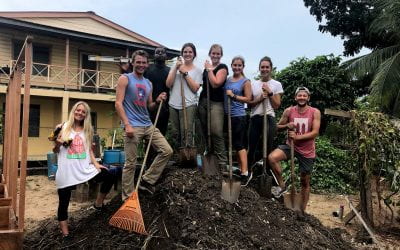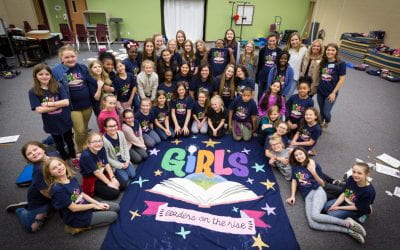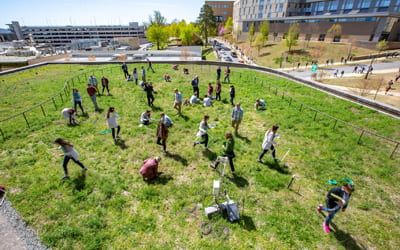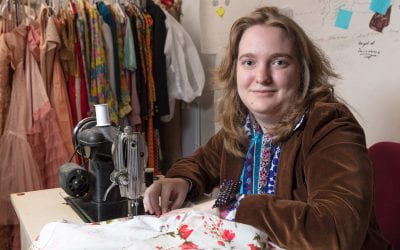Rethinking Suburban Sprawl
By Kendall Curlee
Photos by Russell Cothren
 David Sweere grew up in a classic American suburb in Maumelle, Arkansas, in a single-family home on a corner lot. He recalls a lot of lawn mowing and the fact that “you could see the Kroger grocery store from my house, but you couldn’t walk to it.”
David Sweere grew up in a classic American suburb in Maumelle, Arkansas, in a single-family home on a corner lot. He recalls a lot of lawn mowing and the fact that “you could see the Kroger grocery store from my house, but you couldn’t walk to it.”
Fast forward through eight years of far-flung military service and six years of architecture school, and Sweere is ready to roll up his sleeves and redesign suburban sprawl. Some key texts, including Jane Jacobs’ Life and Death of American Cities and James Howard Kunstler’s The Geography of Nowhere, helped him understand why suburban streets don’t work for pedestrians. A semester in Rome, funded by an Honors College Libby Finch Award, also introduced him to vibrant city streets that do. “That was the best five months of my entire life! The Rome Center is actually on the Via del Cornali, one of the streets included in Allan B. Jacobs’ book Great Streets. For the first time, I lived in a place that’s fully walkable, and I think it had an influence.”
For his honors thesis Sweere decided to document three examples of suburban renewal in the Washington, D.C., area. Thanks to existing urban structures and an efficient mass transit system, the bedroom communities surrounding the capital are ideally suited for “suburban retrofits,” which energize suburbs through the development of denser, more walkable environments. Sweere traveled to the area for one very full weekend, arriving with no advance research, a sketchbook, and eyes wide open. “I wanted a blank slate approach to this, so that I could experience these places through my own eye, as a designer,” he said.
Sweere walked, sketched, diagrammed, photographed and wrote descriptions of three retrofits with the goal of capturing “the sensual qualities of urban form, like the sounds, the temperature, the voices you hear walking down the street, the light quality, the speed of it,” he said. He found Bethesda Row, in Bethesda, Maryland, to be most successful in integrating suburban homes with existing urban fabric. The building scale is modest, and trees and parked cars protect pedestrians from vehicles passing by. Restaurants spill out onto sidewalks, and there’s a steady rhythm of thresholds: “The buildings are constantly reaching out to you and engaging with you, and that’s important, because the pedestrian has to be entertained.” Sweere also noted that a park mediated between the bustle of Bethesda Row and adjacent single-family homes, “something I definitely wouldn’t have gotten if I hadn’t been there, on site.”
The Mosaic District, located furthest from D.C. in Fairfax, Virginia, was least successful. Wide streets were lined with large-scale, upscale buildings with lots of glass but few entrances to engage visitors. “The stores were larger – mostly high-end furniture and décor shops that didn’t drive activity. Restaurants and bars are really the meat and potatoes of walkability.” Experiencing the sites in person was critical, Sweere emphasized: “How does it integrate into the community? Building age, scale, materials, vegetation, and how people are reacting to it – these are things you can only get on site, and it’s a discussion that I think is missing.”
Sweere’s honors thesis, directed by Noah Billig, associate professor of landscape architecture, analyzed the relative merits and failures of these two areas and a third, the Arts District in Hyattsville, Maryland. He expanded on his perceptual and emotional responses to the sites with extensive research, eventually developing an index that defines aspects of walkability, perhaps the most important signifier of successful urban spaces.
More Field Notes
Model Garden to Boost Nutrition, Profits in Belize
A summer of beaches, tasty food, sunshine and a chance to serve. That’s the vision Zan Johnson, Bailey Carpenter, Natalie Zimmerman and Madison Ermert focused on as they tackled yet another pile of soil. Though the group anticipated unexpected adventures during the eight-week service-learning experience in Dangriga, Belize, they never dreamed of the sweat equity, sheer exhaustion and laughter that would accompany their journey.
Girl Power
Close to 40 fifth-grade girls are getting their ya-yas out as they try to maneuver an Oreo from forehead to open mouth – no hands allowed. The exercise invokes chaos, and more than a few cookies crushed underfoot, but the girls are quick to settle into a large circle anchored by Sophia Vincent, an honors education senior who easily commands the room.
Thin Tin
Two Honors College students have tackled – and solved – an important question about matter that sheds new light on the quantum world. Guided by mentor Salvador Barraza-Lopez, associate professor of physics, students Tyler Bishop and Erin Farmer have uncovered new information about tin oxide and have published their research in Physical Review Letters.
Meet Rufus, Your Friendly Campus Green Roof
They’re strange bragging rights – but then again, it is a roof talking. And not just any roof – the U of A’s Hillside Auditorium green roof, which is exactly what it sounds like: a roof covered in about five inches of soil, atop which native plants have been growing since March 2013. The roof, affectionately dubbed “Rufus” by its student supervisors, has been tweeting measurement updates since early February 2019 via a Raspberry Pi microcomputer, thanks to senior Zack Wofford. Wofford was inspired by a tweeting tree he encountered while studying abroad in Ghent, Belgium.
On the Fashion of the Noldor in the First Age
Whether you’re a fan of Tolkien’s Middle Earth or have simply absorbed the cultural references it spawned (my precious…) you likely have a strong mental image of Tolkien’s characters. Galadriel, for example: Cate Blanchett, clad in white and silver, with flowing sleeves and Y-shaped fabric sash. Given the popularity of Peter Jackson’s film trilogy, that’s completely to be expected. But it’s also a problem, says Elkins native Grace Costello, who graduated in December 2018 with a degree in costume design from the Apparel Merchandising and Product Development program in the School of Human Environmental Sciences.

Sidewalk dining sparks urban energy in the Arts District.

Mosaic District Building Footprint 2018.
“That was the best five months of my entire life! The Rome Center is actually on the Via del Cornali, one of the streets included in Allan B. Jacobs’ book Great Streets. For the first time, I lived in a place that’s fully walkable, and I think it had an influence.”
“There are existing systems that score walkability, but they typically rely on quantitative metrics,” Noah Billig said. “David’s index combines both quantitative and qualitative aspects, building on skills and sensibilities he has developed through his years as a design student. He has created a tool that others could use and expand upon.”
When asked where he would retrofit in Northwest Arkansas, Sweere didn’t hesitate: “I’d start at the mall. I’d bring residential to it, office space and shopping. I’d make block sizes much smaller and increase density. There’s so much potential there – the bike trial, JJ’s Grill, the movie theater. We’ve just got to get things to the street edge, to engage pedestrians.”
Sweere’s work was supported by an Honors College Short-Term Research Travel Grant.







